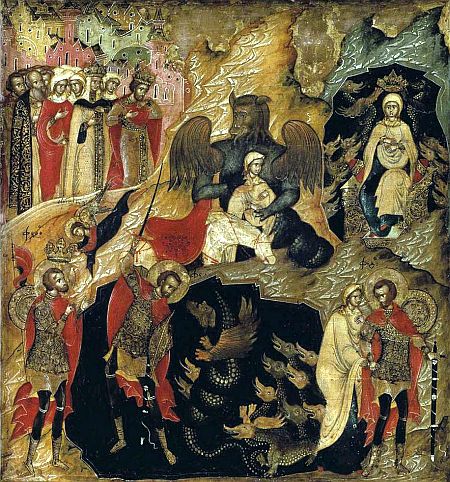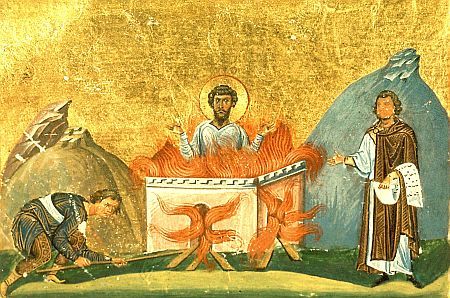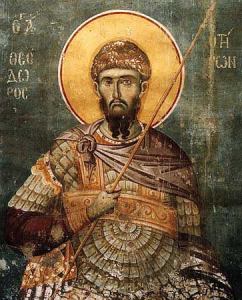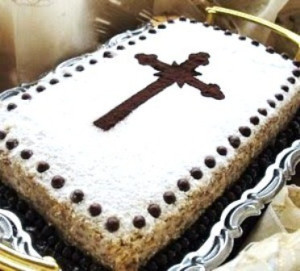The Holy Great Martyr Theodore the Recruit (Tyro) was a soldier in the city of Alasium of the Pontine district (northeast province of Asia Minor, stretching along the coast of the Euxine, i.e. the Black Sea), under the command of a certain Brincus.
They commanded him to offer sacrifice to idols. St Theodore firmly confessed his faith in Christ the Savior in a loud voice. The commander gave him several days to think it over, during which time St Theodore prayed.
They charged him with setting a pagan temple on fire, and threw him into prison to be starved to death. The Lord Jesus Christ appeared to him there, comforting and encouraging him. Brought to the governor, St Theodore boldly and fearlessly confessed his faith, for which he was subjected to new torments and condemned to burning. The martyr Theodore climbed onto the fire without hesitation, and with prayer and gave up his holy soul to God.
This occurred in about the year 306 under the Roman emperor Galerius (305-311). Unharmed by the fire, the body of St Theodore was buried in the city of Euchaita, not far from Amasium. His relics were afterwards transferred to Constantinople, to a church dedicated to him. His head is in Italy, in the city of Gaeto.
Later on, fifty years after the death of St Theodore, the emperor Julian the Apostate (361-363), wanting to commit an outrage upon the Christians, commanded the city-commander of Constantinople during the first week of Great Lent to sprinkle all the food provisions in the marketplaces with the blood offered to idols. St Theodore appeared in a dream to Archbishop Eudoxius, ordering him to inform all the Christians that no one should buy anything at the marketplaces, but rather to eat cooked wheat with honey (kolyva).
Kollyva
(Greek: Κολλυβα, (kólliva); Serbian: кољиво, (koljivo); Romanian: colivă ; Bulgarian: коливо, (kolivo); Ukrainian and Russian: Kutya (or Kutia)) is an offering of boiled wheat that is blessed liturgically in connection with the Memorial Services in Church for the benefit of one’s departed, thereby offering unto God, as it were, a sacrifice of propitiation (atonement) for the dead person, and in honor of the Sovereign Lord over life and death.
The Kollyva are symbolic of the resurrection of the dead on the day of the Second Coming of the Lord. St. Paul said, “what you sow does not come to life unless it dies” (I Corinthians 15:36), and St. John, “unless a grain of wheat falls into the earth and dies, it remains alone; but if it dies, it bears much fruit” (John 12:24).
Thus, as the wheat is buried in the soil and disintegrates without really dying but is later regenerated into a new plant that bears much more fruit than itself, so the Christian’s body will be raised again from the very corruptible matter from which it is now made; however, it will be raised not in its previous fleshy substance but in an incorruptible essence which “will clad the mortal body with an immortal garment”, in the words of St. Paul (I Corinthians 15:53).
The Kollyva then, symbolize the Apostolically rooted hope in the resurrection of the dead as the only eventuality that gives meaning and attains the longed perfection on the part of the individual who takes his life to be a divinely ordained meaningful living forever.
The 16th century Archbishop Gabriel of Philadelphia wrote that the Kollyva are symbols of the general resurrection, and the several ingredients added to the wheat signify so many different virtues.
During memorial services (requiem services), the family or friends of the departed will often prepare a Kollyva which is placed in front of the memorial table before which the service is chanted, while submitting a list of first names of the deceased loved ones to the priest. Memorial services are served on the third, ninth, and fortieth days after the repose of an Orthodox Christian, as well as on the one-year anniversary.
St. Theodore Saturday
In memory of this occurrence, the Orthodox Church annually celebrates the holy Great Martyr Theodore the Recruit on the first Saturday of Great Lent. On Friday evening, at the Divine Liturgy of the Presanctified Gifts following the prayer at the ambo, the Canon to the holy Great Martyr Theodore, composed by St John of Damascus, is sung. After this, kolyva is blessed and distributed to the faithful. The celebration of the Great Martyr Theodore on the first Saturday of Great Lent was set by the Patriarch Nectarius of Constantinople (381-397).
The Troparion to St Theodore is quite similar to the Troparion for the Prophet Daniel and the Three Holy Youths (December 17, Sunday Before Nativity). The Kontakion to St Theodore, who suffered martyrdom by fire, reminds us that he also had faith as his breastplate (see I Thessalonians 5:8).
We pray to St Theodore for the recovery of stolen articles.





